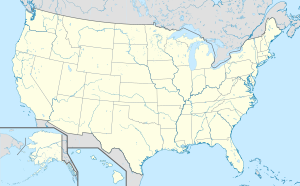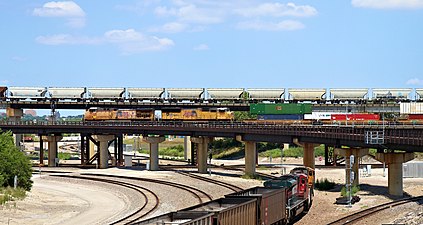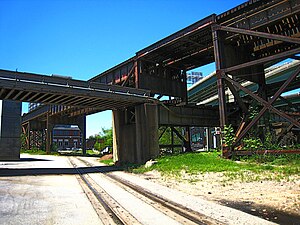Argentine Connection Bridge
Coordinates: 39 ° 4 ′ 55 ″ N , 94 ° 36 ′ 18 ″ W.
| Argentine Connection Bridge | ||
|---|---|---|
| East side of the Santa Fe Junction in KCMO with the Argentine Connection Bridge in the background, in front of it the access to the upper level of the Highline Bridge | ||
| use | Railway bridge | |
| Crossing of | Santa Fe Junction | |
| place | Kansas City, Missouri and Kansas City, Kansas | |
| Entertained by | Kansas City Terminal Railway | |
| construction | Girder bridge | |
| overall length | 756 m | |
| Longest span | approx. 40 m | |
| building-costs | US $ 60 million | |
| opening | 2004 | |
| location | ||
|
|
||
The Argentine Connection Bridge (also Argentine Connection Flyover ) is a double-track railroad bridge of the Kansas City Terminal Railway (KCTR) over the Santa Fe Junction on the border between Kansas City (Missouri) and Kansas City (Kansas) . It was built in 2004 to relieve the heavily frequented railway junction and on a third level it leads the east-west connection of the BNSF Railway to the Argentine Yard, which gives it its name . The bridge crosses several tracks of north-south connections at ground level and the double-track access to the upper level of the KCTR Highline Bridge in the north-west ( double-decker bridge over the Kansas River ).
history
In the early 2000s, over 125 trains drove daily on two levels across the KCTR's Santa Fe Junction , with a few rail crossings at ground level that obstructed the flow of traffic. With support from the Missouri Department of Transportation and the Unified Government of Kansas City, County Kan./Wyandotte the KCTR planned for 120 million US dollars , the transformation of the important railway junction. For US $ 60 million each, the western Highline Bridge over the Kansas River was overhauled by 2005 and a double-track overpass was built by 2004 for the approximately 60 trains of the BNSF Railway and Amtrak ( Southwest Chief ), which daily along the east-west Connections to and from the Argentine Yard . The Argentine Connection Bridge also required extensive changes to the track layout of the Santa Fe Junction , which were completed in September 2004.
The Triple Crossing in Richmond, Virginia from 1901
In addition to the Triple Crossing in Richmond (Virginia) , the Santa Fe Junction is the second rail junction in the USA, where tracks cross on three levels.
description
The 756 meter long railway bridge consists of 31 bridge fields, each of which is made up of four parallel beam girders per track. The construction of the girders of 23 bridge fields is made of prestressed concrete and eight are made of solid steel wall girders , the latter being used for the large spans of up to 40 meters. The girders rest on two round reinforced concrete pillars that are connected in the upper area. At some points on the Santa Fe Junction , the girders could not be placed directly on the pillars due to the track layout and underground infrastructure, and they rest here on additional steel cross girders, each supported by two separate round reinforced concrete pillars. Including the access ramps, the length of the double-track expansion was 2.8 kilometers.
The height of the track level of the highline of the double-decker bridge of the same name , which forms the intermediate level of the railway junction, is 30 ft (9 m ), the maximum height of the upper track level on the Argentine Connection Bridge is 80 ft (24 m ).
Web links
literature
- James P. Hyland: Argentine Connection Bridge Triple Track Crossing. Arema Conference Proceedings, 2004.
Individual evidence
- ^ Brian Cookson: Railway putting flyover on track. Kansas City Business Journal, November 4, 2001, accessed May 18, 2020.
- ↑ Stacie Hamel: 3-deck bridge helps trains to 'fly over'. Brotherhood of Locomotive Engineers and Trainmen, September 14, 2004, accessed May 18, 2020.
- ^ BNSF begins to move trains across Kansas City flyover. Progressive Railroading, September 14, 2004, accessed May 18, 2020.
- ↑ a b James P. Hyland: Argentine Connection Bridge Triple Track Crossing. Arema Conference Proceedings, 2004.
- ^ Elevated Terminal Connection at Kansas City. In: Railway Age. Vol. 64, No. 10, 1918, pp. 493-497.
- ^ Charles J. Stenzel, James A. Giblin: Rail Flyovers Transystems. CMAP Freight Advisory Committee, Chicago, IL, January 24, 2011, accessed May 20, 2020.




